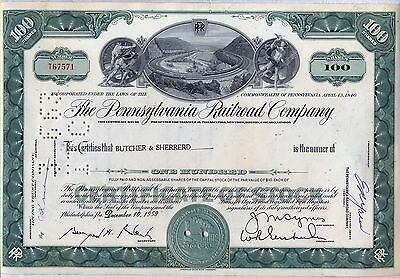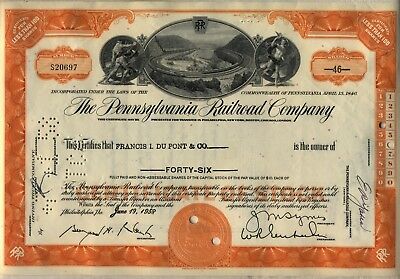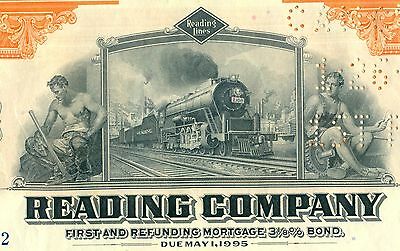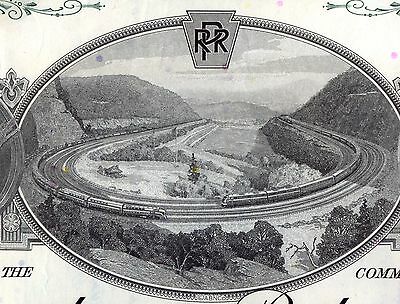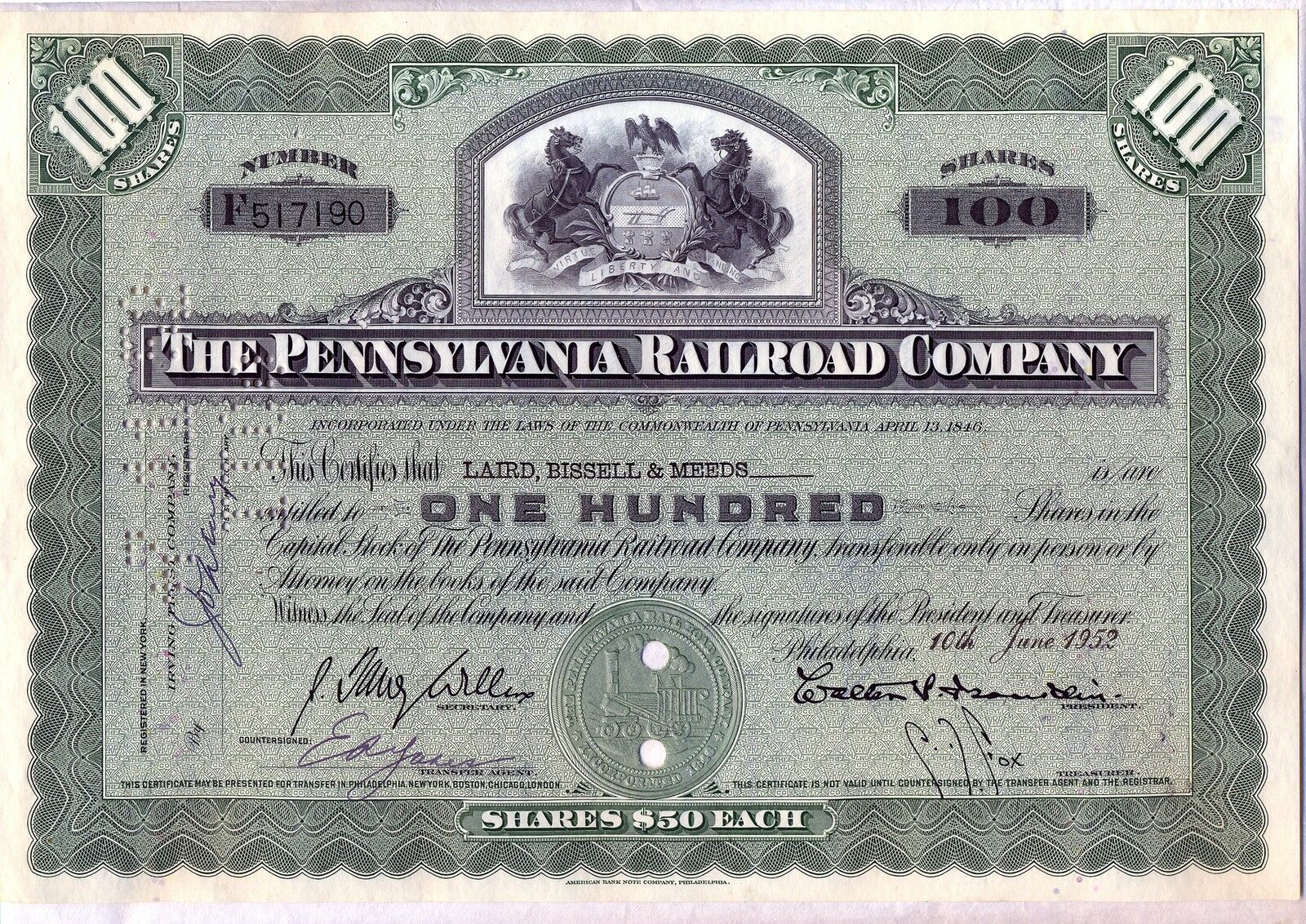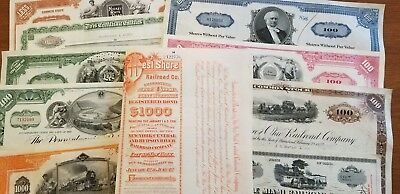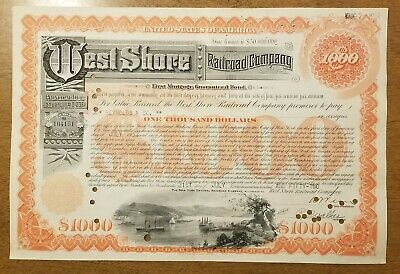-40%
New York, Ontario and Western Railway Company Bond Certificate
$ 9.5
- Description
- Size Guide
Description
Product DetailsBeautifully engraved antique bond certificate from the New York, Ontario and Western Railway Company dating back to the 1920's. This document, which has been signed by the company President and Secretary, was printed by the Franklin Bank Note Company and measures approximately 13 1/2" (w) by 8 3/4" (h).
This certificate features a nice vignette of a series of trains at coal mill.
Images
You will receive the exact certificate pictured.
Historical Context
The New York, Ontario and Western Railway, more commonly known as the O&W or NYO&W, was a regional railroad with origins in 1868, lasting until March 29, 1957 when it was ordered liquidated by a US bankruptcy judge.
The railroad began life as the New York and Oswego Midland Railroad, organized by Dewitt C. Littlejohn in 1868.
The railroad's mainline ran from Weehawken, New Jersey in the greater New York City area to Oswego, New York, a port city on Lake Ontario. It had branch lines to Scranton, Pennsylvania, Kingston, New York, Port Jervis, New York, Utica, New York and Rome, New York. The part south of Cornwall, New York was operated over the New York Central Railroad's West Shore Railroad via trackage rights.
History
In 1880 O&W inherited the Oswego - New York corridor as well as the branches to Ellenville, Delhi and New Berlin, NY from the New York & Oswego Midland, which had constructed the lines. O&W improved the line by providing a new entrance to Gotham from Middletown, NY which ran to Cornwall on the Hudson River and then to Weehawken, NJ. This development was made possible by negotiating rights of way from the New York, West Shore & Buffalo Railway, later the New York Central.
In 1881, when the NY & Oswego Midland became the O&W, things looked brighter. The bluestone industry was in full flower throughout the area served by the railroad and there was no truck competition. To tap important coal regions in the Scranton area, a 54-mile branch was built from Cadosia in 1889. This opened up the O&W as a mover of anthracite coal to New England and to the New Jersey ports. The mines failed in the late 1930's, forcing a 1937 reorganization.
In 1886 the O&W acquired the operations of both the Utica, Clinton & Binghamton and the Rome & Clinton railroads from the Delaware & Hudson Canal Company. By acquisition of these assets and construction of a new line to Sylvan Beach on the east shore of Oneida, O&W extended its operations into new market areas and the Sylvan Beach Loop becamea seasonally significant corridor by providing transportation to central New York's recreational resort area. By 1889, the O&W added two new branches, New Berlin to Edmeston (which was eventually sold to the Unadilla Valley); and Delhi, Port Jervis and Monticello, connecting to the main line at Summitville, NY.
The most significant addition came in 1890 when the O&W constructed a 54 mile branch from Cadosia, NY to Scranton, PA through the rich anthracite coal reserves in Pennsylvania's Lackawanna Valley. There, the line connected with the Delaware, Lackawanna & Western and the Central of New Jersey. Revenues from this Scranton division strengthened O&W's revenues and provided the means for future improvements to the railroad.
As the mainline wound its way through out of the way places towards Lake Ontario, it spun off a branch from near Hamilton to Utica. As this branch went through Clinton, another branch went to Rome. The Utica, Clinton & Binghamton Railroad was owned by the Delaware & Hudson, leased to the O&W, and finally sold to the O&W in 1942 for 0,000. The Rome & Clinton Railroad was sold by the D&H to the O&W in 1944. The D&H owned these disconnected lines as a result of an 1873 loan to the NY & Oswego Midland that was defaulted. The D&H had made the loan in hopes that it would bolster coal traffic over the D&H.
One of the incorporators of the railroad joked that the O&W would run at right angles to the mountains. The road dug several tunnels and many bridges and trestles to keep the grade from too steep a pitch. It is said that, for its size, the O&W had more causeways, bridges and tunnels than any other Eastern road. By the turn of the century, the railroad served over a hundred stations.
Middletown was the nerve center of the railroad. All major repairs were made at the locomotive and car shops there. Light running repairs were made at Scranton and Norwich. Also at Middletown were machine shops, blacksmith shop, woodworking shop, paint shops and other supporting facilities. The line had two coal piers in Weehawken and 35 acres of lake front at Oswego.
This line with 37 locomotives, 541 miles of track, freight yards, brakemen, etc was doomed to disappear from the New York scene. The line on which hundreds of families were dependent and which numerous businessmen moved their merchandise became extinct.
During its history, the road was owned by the New Haven for several years beginning in 1904.


